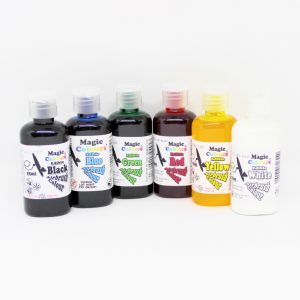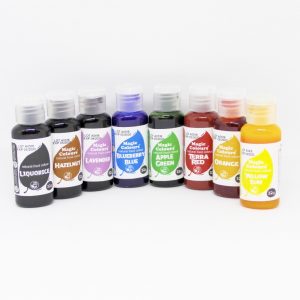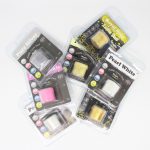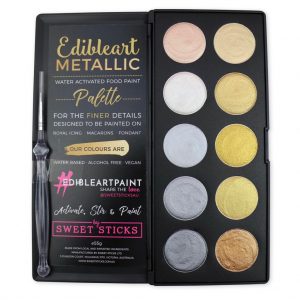Edible Food Colours
Colours make a cake stand out and colour combinations can make or break the cake. Often the theme of the party will dictate the colours to be used. Finding the right colour and shade can be the tricky part, as there are many different brands and products.
Most products have the colour pictured on the packaging, however many factors can cause the colour to vary. Icing ingredients may affect the colour – Swiss meringue buttercream is a good example of it. Colour can also change over time. Most colours deepen with the time, but purple will actually turn into blue when left out in daylight.
There used to be only liquid, paste, gel and powdered food colours available. Now days the variety is much bigger and options are pretty much endless.
Types of Edible Food Colours
Powdered Food Colours
Powdered food colours are highly concentrated and are good to colour chocolate. It is best to dissolve the powdered food colour granules before mixing the colours into the icing or chocolate.
If you mix the powdered food colours directly into the icing, there may be speckles of colours throughout.Gel and Paste Food ColoursGel edible colours are water based and highly concentrated. Because of the water content they are not suitable for colouring the chocolate, as it will seize the chocolate.
Small amounts will go long way, and colours usually deepen with the time. Start up with the lighter shade, wait for hour or two and see if you need to adjust the shade of colour.
Liquid Food Colours
Liquid edible colours are commonly found at supermarkets. Liquid food colours are best suited for pastel colours as they are not as concentrated as gels, pastes or powdered food colours. To achieve a dark colour, you’d need to use large amount of food colour that can change the consistency of your icing. Liquid food colours are also water based, so again, not suitable to colour chocolate or ganache.
Airbrush Food Colours
Airbrush edible colour is a liquid food colour. You shouldn’t use any other colours in your airbrush gun, besides the ones that are specially marked for it. Gel and paste food colours will clog the airbrush and ruin the expensive machine. Airbrush food colours come in standard colours as well as metallic shades.

Oil Based Food Colours (Candy Colours)
Oil based food colours don’t contain any water so, it is safe and to use them on chocolate, ganache and candies.
Natural Food Colours
There are natural food colours available made with natural ingredients such as beets, turmeric, spirulina and other plant extracts. These colours are usually not very concentrated and will add only pastel shades to your icing. Natural food colours may also change the colour when cooked at high temperatures.

Edible Dusting Powders
Edible powder dusts are available in matt, pearl or metallic finish. These powders are not designed to mix with fondant or icing. As the name suggest, you are meant to brush them on to finished decorated products to add colour or shimmer.
Dusting powders can also be mixed with clear alcohol or cake decorators rose spirit to turn them into paint. Matt finished dusts are also called petal dusts, these can essentially be used as a light powdered food colouring when mixing with fondant or paste, but will never give you the same effect than the actual powdered colours.
Lustre dusts produces a subtle colour with metallic, pearl or glitter like sheen finish.

Under this category you can also add “edible” glitter. Until recently no one really paid much attention to whether edible glitter is really edible or not. In reality, most of the glitters are actually labelled as “non toxic” and should not be consumed.
Non-toxic glitters won’t kill you, but they are not considered food and should not be consumed in large quantities. When you buy edible glitter next time, you should carefully check the label to see if it’s marked “edible” or “non toxic”.
Edible Food Pens
Markers containing food colour are a convenient method of applying colour on hard surfaces. Food pens are perfect to add fine lines or writing to your edible projects. Edible markers are great to use for artistic detailing on cakes, cookies, macarons and more in true and vibrant colours. Edible food pens will write on any dried, firm food surface.
Food Colour Sprays
Edible food colour sprays act kind of like airbrush machines. They are affordable and you won’t have to buy extra equipment to use them. Edible food sprays come in different traditional shades as well as sparkly lustre colours.
Edible Food Paint
Edible food paints are ready to use straight from the bottle. There is no need to thin it out or mix it with any other ingredients. Once applied and dried the pigment is sealed within the surface - no dust or smudges. Edible food paints come in traditional colours and also in a metallic shimmering range. Edible food paints make cake decorating much quicker and easier.

Metallic Paint Palette
Metallic Edible Art Paint Palette by Sweet Sticks is a 100% edible, alcohol free, vegan friendly metallic palette that is activated by water. To use simply activate with water, stir to form paste and paint. When finished, close the lid until next time. Great for vegans and those who cannot have alcohol in their cake decorating. Great for achieving fine details on sugar cookies, macarons, royal icing, fondant and more.

Food Colour Tips and Tricks
Dark Colours
Dark colours such as red, dark purple and black require a lot of food colour. Too much colouring though may make the icing bitter, colour your mouths and also change the consistency of the icing. For best results, use gel or paste food colours cause it’s too difficult to get deep colours with liquids. It’s also a good idea to use airbrush colours, sprays or edible paint so you can just colour your icing over, and don’t have to mix it in.
Black icing is probably the most difficult to achieve. For black icing, I’d recommend to start with the brown colour first. Use either dark chocolate ganache or mix some cocoa powder with vegetable shortening to your fondant.
Colour Fading
This is very common problem with purple food colour. If left out in daylight, within couple of hours the purple edible colour can turn into blue. To avoid that, keep your finished cakes in a cool, dark room, or cover them with the box. Other common food colours that may fade are reds and pinks.
Colour Darkening
This is very common when colouring the buttercream. Always colour your buttercream an hour or two before you need to use it to see if it’ll change the colour and if you need to adjust it.
Colour Bleeding
Colours may bleed when moisture affects the icing. For best results make sure your buttercream has a strong crust on it before adding contrasting colours on it. Make sure your cakes are room temperature before adding any coloured details. Even when following all the precautions, deep colours may still bleed, so often it’s easier to wait until the last minute to add contrasting colours.
Colour Staining
Rub small amount of shortening in hands before kneading food colour into the fondant, to keep hands from getting badly stained.
Warning
Edible food colours will stain porous surfaces, including countertops. You need to use bleach or a powdered cleanser on countertops to remove stains.

